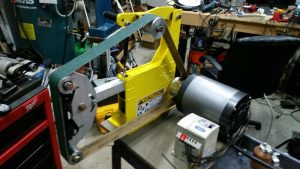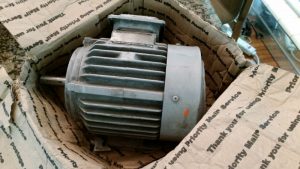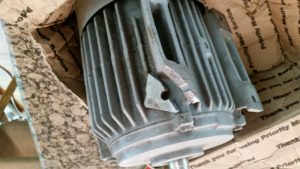Welcome to the Popular Mechanics Swimsuit Issue
September 10th, 2016Introducing Our First Model
A few people actually commented on my last blog post, which involved a motor I cleaned up for use with a grinder. Now that I realize what a giant hit my motor essays are, I have decided to post another photo.
Here is the motor, sitting on the platform I have to re-drill and repaint, with the variable frequency drive I have to put in an enclosure.
You have to admit, it looks nice considering what it used to be. The new used wave spring I ordered arrived yesterday, so I’ll be installing that later.
I finally realized that you restore a lumpy shaft by filing in the axial direction, not across the shaft, so I may try to polish this motor’s shaft a little more. It’s not perfect. A real man would put it on the lathe, but that involves pressing the bearings off, so I would have to get new bearings.
The new used motor I ordered is supposed to arrive today, so I’m not sure why I did all that work, but if I ever need a 2-HP Totally Open to Crap motor, I’ll have one on deck.
Out of curiosity, I looked into motor longevity. Apparently, no one actually knows how long a motor should last. For one thing, no one has defined “motor death.” Is it when the bearings go bad? Is it when the wiring burns up? There is no consensus.
Leeson (DISCLAIMER: a company that really wants you to trash your old motors and buy the new ones it makes) says you can hope for something like 15 years of operation, and I assume that’s in industrial applications. If not, a lot of people who buy Leeson motors will be hopping mad, because a motor that lasts 15 years in a factory will last three months in your house.
When bearings go bad, you can replace them for a few dollars. Bearing death is not motor death. If I understand things correctly, the real problem comes when the insulation on the stator breaks down, and this can be accelerated by heat or current spikes (which, actually, equal heat).
I wondered about this, because there are always tons of used motors available on Ebay. How do you know what condition the stator is in? You don’t. A motor can look really nice on the outside without telling you much abot the inside. Maybe some of those 75%-discounted Ebay motors aren’t great deals. Or maybe they are, if insulation breakdown takes several decades. Some motors appear to be immortal, continuing to run after nearly a century, so it may be that there are motors out there with insulation so wonderful they are very hard to ruin.
I do not know.
In my garage, even a Chinese motor made the day after a major drunken holiday will probably outlive me, because I don’t use them much.
You shouldn’t use a belt grinder which isn’t anchored correctly, or which doesn’t have proper protection for the motor or VFD, so of course, I am already using this grinder. I’m not using it much, though. I used it at about 600 RPM to clean the remaining milling marks off a knife I’m making. It worked great. It was slow, because I refused to turn the speed up, but it beat the daylights out of using sandpaper or a whetstone.
A surface grinder would have knocked it out in 10 minutes, and it would have left the knife with a very precise thickness, but I don’t have a surface grinder.
This project is going really well. Even when I do the wrong things, I am succeeding at them.
Some day you’ll see a finished knife here. And won’t that be special?
Update
The new motor arrived. Check it out.
Can you believe that? The seller jammed it into a flat rate box. Naturally, the Post Office destroyed it. I wonder if they do that deliberately, just to punish people for mailing things they don’t want to carry.
The base is broken, and the fan shroud is crushed. The shaft will not turn.
To his credit, the seller refunded the cost of the motor plus shipping.
Back to Ebay, I guess.


